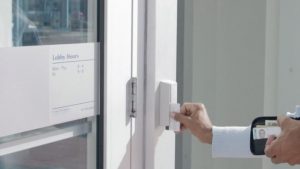Most effective systems combine cards, cameras, databases
Today, locks and keys alone aren’t enough to keep a school’s perimeter secure against unwanted or uncontrolled visitors. From problems with non-custodial parents in a grade school to unauthorized residence hall guests on a college campus, controlling access with greater certainty is the first line of defense to keep a facility and its inhabitants secure.
Many K-12 schools, reacting to instances of school violence, have become more diligent about checking who is coming in and out of their facilities. Some schools merely require visitors to stop into the central office, sign in and place a sticker on their lapel. Others may ask visitors to show some identification before receiving a sticker. More elaborate systems require visitors to provide identifying information that is checked against sex-offender registries, fingerprints or criminal records before a computer-generated visitor badge with photo is issued.
 However, due to violent events on campuses, schools and colleges of all types and sizes are becoming more aware of the security risks posed by unauthorized access and are taking proactive steps – including installation of access control systems – to prevent a broad range of potentially threatening or dangerous incidents.
However, due to violent events on campuses, schools and colleges of all types and sizes are becoming more aware of the security risks posed by unauthorized access and are taking proactive steps – including installation of access control systems – to prevent a broad range of potentially threatening or dangerous incidents.
Consider this: In the K-12 field alone, each of the more than 100,000 public and private schools may have between eight and 20 doors that require perimeter security. What is the most effective way to manage access through that many points of entry?
Electronic access control systems are becoming the standard for school districts to control who and when parents, employees and visitors have access to a school site. An electronic access control system is a series of devices used to control access to a location by checking an individual’s credentials against a database within the system. If the individual has been vetted, and should be allowed access, the system will unlock the point of entry, grant access and make a log of the transaction.
Electronic access can also be customized for the individual user. As an example, access by user may be limited to day or time or point of entry. Or, if an employee is terminated, their access can be stopped immediately.
One of the greatest benefits of this type of electronic credentialing versus a traditional key and lock is in the event of a credential being lost or stolen. The missing credential can simply be deactivated and a new one issued. There is never a need to re-key locks and reissue keys to large numbers of employees when a key is missing. This benefit is one of the many reasons that electronic access control is superior to a traditional key and lock system.
More elaborate systems exist which require visitors to provide identifying information that is checked against sex-offender registries, fingerprints or criminal records before a computer-generated visitor badge with photo is issued.
Preventing piggybacking
A potential security gap for many electronically controlled entrances exists. It’s the practice of piggybacking or tailgating. That’s when a person authorized to enter a building uses their card or PIN to allow someone who may or may not be permitted into the building to come through the entrance.
A report from School Security Technologies says the problem is not the type of system being used, but the behavior of the users. It suggests that schools take these steps to combat the practice:
- Prioritize the training and implementation of access protocols to assure consistency every time.
- Video monitoring or on-site security personnel that trigger alarms when piggy-backing occurs.
- Video recording of incidents to identify intruders.
- An access-control response, such as a lockdown of a second door preventing further entry, and an immediate response from security guards to confront intruders.
School districts must continually seek new and innovative ways to secure their sites. Electronic access control systems offer far superior protection to traditional key and lock systems and have long term cost savings by reducing the amount of re-keying locks and reissuing keys to employees due to lost or stolen keys. Systems can be integrated with other security measures in place such as intrusion alarms and camera systems to achieve maximum performance from all technology used for security.
Sonitrol Great Lakes believes the safety of students and staff members is the main concern of everyone tasked with security, and we should never stop looking for new ways to keep our school campuses safe and secure. Contact us to learn more about integrating your security system with electronic access controls.


